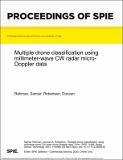Multiple drone classification using millimeter-wave CW radar micro-Doppler data
Abstract
This paper investigates the prospect of classifying different types of rotary wing drones using radar. The proposed method is based on the hypothesis that the rotor blades of different sizes and shapes will exhibit distinct Doppler features. When sampled unambiguously, these features can be properly extracted and then can be used for classification. We investigate various continuous wave (CW) spectrogram features of different drones obtained with a low phase noise, coherent radar operating at 94 GHz. Two quadcopters of different sizes (DJI Phantom Standard 3 and Joyance JT5L-404) and a hexacopter (DJI S900) have been used during the experimental trial for data collection. For classification training, we first show the limitation of the feature extraction based method. We then propose a convolutional neural network (CNN) based approach in which the classification training is done by using micro-Doppler spectrogram images. We have created an extensive dataset of spectrogram images for classification training, which have been fed to the existing GoogLeNet model. The trained model then has been tested with unseen and unlabelled data for performance verification. Validation accuracy of above 99% is achieved along with very accurate testing results, demonstrating the potential of using neural networks for multiple drone classification.
Citation
Rahman , S & Robertson , D A 2020 , Multiple drone classification using millimeter-wave CW radar micro-Doppler data . in K I Ranney & A M Raynal (eds) , Radar Sensor Technology XXIV . , 1140809 , Proceedings of SPIE , vol. 11408 , SPIE , SPIE Defense + Commercial Sensing , 27/04/20 . https://doi.org/10.1117/12.2558435 conference
Publication
Radar Sensor Technology XXIV
ISSN
0277-786XType
Conference item
Description
Funding: Army Research Laboratory under Cooperative Agreement Number: W911NF-19-2-0075.Collections
Items in the St Andrews Research Repository are protected by copyright, with all rights reserved, unless otherwise indicated.

